St Ultan’s: a women’s hospital for infants
Published in 20th Century Social Perspectives, 20th-century / Contemporary History, Features, Issue 4 (Jul/Aug 2005), Volume 13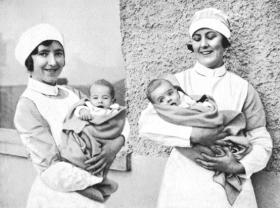
‘The convalescent smile’—taken from a 1930 promotional brochure. (Daily Mirror)
St Ultan’s Hospital was established in 1919 by Dr Kathleen Lynn and Madeleine ffrench-Mullen in response to socio-medical conditions in Dublin. It was not unusual for women to establish hospitals. This had happened in Britain and the United States in the late nineteenth century to facilitate women’s access to the medical profession. Women on missionary activity in India and China had established hospitals for the local population. Although the Ulster Hospital for Women and Children and the Belfast Hospital for Sick Children were established in 1873 by men, they provided employment for female doctors. International developments also motivated St Ultan’s founders, as they noted that Dundee, Manchester and London had opened hospitals for women.
Establishment
Female members of Sinn Féin established Cumann na dTeachtaire (League of Women Delegates). These women were involved in the early stages of setting up St Ultan’s Infants’ Hospital. They were interested in what were perceived as women’s affairs, such as children’s health and hygiene. Not surprisingly, there was a great need for medical care in the aftermath of World War I, with increased cases of venereal disease and the world-wide flu epidemic that took many lives. The British Ministry of Health noted that there was a large increase in attendance at venereal disease clinics in 1919. In Ireland, the Lock Hospital (an institution specifically for venereal disease) noted that attendance at the outpatients department was 900 for the year 1920–1, and this was ‘an increase of upwards of 600 upon the previous year’. The extern department had only been introduced in 1919. By 1922–3 the numbers being treated declined. The annual report referred to 23 ‘healthy children’ born to mothers infected with the disease. It was in response to these problems that St Ultan’s was established, since the hospital committee reported that the village of Artane was ‘crowded with war babies, some of them suffering from syphilis’.
The care of infants was not given a high priority by the medical profession in general. Several authors noted that paediatrics did not occupy a high place in the medical hierarchy. Mowbray, in a history of Temple Street Children’s Hospital, commented that it was not on the final medical examination syllabus until 1956, while Dr Barbara Stokes believed that paediatricians were on a par with vets, since, in both cases, their patients could not ‘talk back’. Dr Robert (Bob) Collis, writing of the 1930s, suggested that the ‘position of paediatrics at that moment in Dublin was very much at its beginnings and the prospects of being able to support oneself rather slim’. However, Dr Pearl Dunlevy, who was heavily involved in the BCG vaccination campaign (which helped to eliminate tuberculosis) in the 1950s, believed that jobs were easier to obtain in paediatrics. It is not surprising, then, that women doctors should turn to a speciality where they could gain a foothold.
Kathleen Lynn
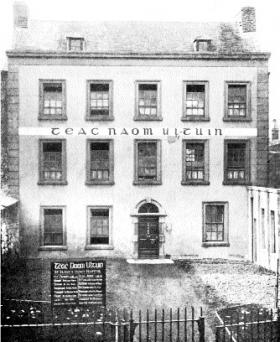
St Ultan’s, 37 Charlemont Street, Dublin, in 1919. (Teach Ultáin Infant Hospital)
Dr Kathleen Lynn had received her medical degree in 1899. Her career was primarily concerned with the less well-off. After working in Sir Patrick Dun’s Hospital and the Royal Victoria Eye and Ear Hospital between 1902 and 1916, she devoted herself to St Ultan’s and her private practice in Rathmines. An enthusiastic nationalist, Dr Lynn was Chief Medical Officer of the Irish Citizens’ Army (ICA) during the 1916 Rising and was imprisoned afterwards. Ffrench-Mullen was born in Malta, where her father was a naval doctor. Following her father’s death, the family moved to Germany. Ffrench-Mullen left in 1914, and met Dr Lynn the same year. During World War I she helped Belgian refugees in Ireland. Ffrench-Mullen shared the political outlook of Dr Lynn. She had been a member of the ambulance corps of the ICA and was later a sergeant. Like Lynn, she was a nationalist and a suffragist. Ffrench-Mullen acted as the administrator of St Ultan’s Hospital.
The hospital was fortunate from the very beginning in having an experienced matron, Nan Dougan, a native of County Derry, who had trained at Sir Patrick Dun’s Hospital. But why was this infants’ hospital established in the first place? The people associated with St Ultan’s, such as Dr Ella Webb, Dr Elizabeth Tennant, Dr Katherine Maguire, Dr Alice Barry, Madeleine ffrench-Mullen and Dr Lynn, were all interested in children’s health. The first meeting of the committee, which established the hospital, was primarily concerned with venereal disease. Many political figures were present at the meetings, such as Mrs Kathleen Clarke and Mrs Jennie Wyse-Power. Wyse-Power had a long career in public life, from the Ladies’ Land League to Cumann na mBan. She was to become a senator in the 1920s. Clarke was active in local government and became lord mayor of Dublin.
At the first meeting Dr Lynn, who read a paper on venereal disease, declared her desire to educate the public on the matter. Dr Alice Barry proposed, and Miss Lucy Griffin (later secretary of St Ultan’s committee) seconded, the motion that ‘this conference of Irishwomen note with appreciation that the corporations of Dublin and Belfast have taken up the question of venereal disease, and urge those bodies to see that every soldier who lands at Irish ports is guaranteed free from disease’. This concern was not solely the preserve of Cumann na dTeachtaire. There was a Royal Commission on venereal disease sitting in 1918. Dr McWeeney, professor of pathology and bacteriology at Cecilia Street Medical School and bacteriologist to the Local Government Board, had been asked to present a paper with slides to the Statistical and Social Inquiry Society of Ireland on the subject. He gave the paper in January 1918. It was subsequently published, regrettably without the slides. At the same time, the Irish Journal of Medical Science had several pieces on the subject.
Nationalist links
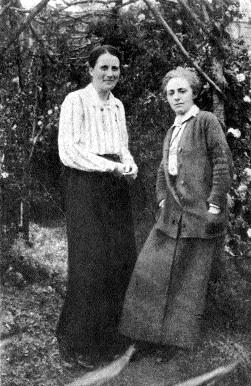
Kathleen Lynn (left) and Madeleine ffrench-Mullen in 1919. (Teach Ultáin Infant Hospital)
Furthermore, given their nationalist outlook, the committee were particularly critical of British and Irish soldiers infecting Irish women and children. Dr T.P.C. Kirkpatrick, in an article in the Irish Journal of Medical Science, referred to a leaflet issued by the ‘Sinn Fein Public Health Department, in which it is stated that at the close of the war probably 15,000 soldiers will return to Ireland suffering from syphilis’. The committee possibly saw this development in a wider political context. British rule was affecting the health of the nation. It could be argued that St Ultan’s wanted to improve children’s health, just as the Gaelic League sought to enhance Irish language fluency. Both organisations were concerned with reviving the nation. The St Ultan’s committee was also part of a group known as Sláinte na nGaedeal, which was interested in the health of the nation. They were part of a national movement that sought the cultural, moral, physical and intellectual regeneration of the Irish people through organisations such as the Gaelic League and the GAA.
The St Ultan’s committee recommended that ‘local authorities under the Children’s Act . . . [should] have such infants [suffering from syphilis] immediately removed for treatment to hospitals on diagnosis of their disease by the medical officer of the district, and that copies of this resolution be sent to Boards of Guardians and local authorities’. They also asked whether there was provision for syphilitic infants in any hospital. By May, the committee had sent Miss Lucy Griffin to see P.T. Daly, a nationalist member of Dublin Corporation, regarding health facilities.
These early issues underline a number of different developments that affected female doctors. The increasing role of the state (including local government) in medicine, and the growing importance of paediatrics and public health (the two were closely linked), provided a focus for female doctors, who, by this stage, had been part of the medical profession for over three decades.
By July 1918 arrangements were being made to buy 37 Charlemont Street, the eventual site of the hospital. When the influenza epidemic reached Dublin in November 1918, the committee appealed directly to the public. Dr Lynn and ffrench-Mullen met Dr William Walsh, the Catholic archbishop. It was reported, in the minutes, that ‘the archbishop never likes [the words ‘would not’ were scored out] to share in the starting of an enterprise like this for which he is not directly responsible, [and] that he will be guided in his support by the advice of his medical advisers. [He also] recognises the need of such a hospital . . . [and] he is sympathetic towards it’. Despite this qualified support, the committee published the archbishop’s approval in the daily papers on 1 January 1919.
Funding
A book entitled Leabhar Ultáin. The Book of Saint Ultan was compiled in 1920 by Katherine MacCormack and sold to support the hospital. It contained an introduction by the historian Alice Stopford-Green (the aunt of Dr Dorothy Stopford-Price, who later worked in St Ultan’s), poems, drawings and pictures by George Russell, Maud Gonne MacBride, Thomas Bodkin, Harry Clarke and Jack B. Yeats, among others. Every year the hospital organised a pilgrimage-cum-picnic to Ardbraccan, Co. Meath, the site of St Ultan’s well and his tiny church. This multi-denominational outing usually consisted of a Rosary and Evensong in Irish. Dr Lynn, along with Seán O’Casey, wanted to
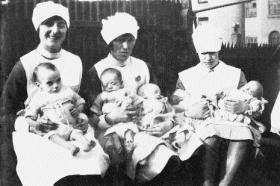
Infants (l–r) Betty, George, Jack, Kate and Joseph with unnamed nurses, March 1929. (Teach Ultáin Infant Hospital)
Gaelicise the Church of Ireland liturgy. In 1921 the committee thanked de Valera for permitting them to advertise that ‘he was coming to the aeraiocht (outing)’, as it increased attendance fivefold. Many of the St Ultan’s events were advertised in Irish, thus linking their activities with nationalist movements. The hospital maintained its connections with individuals associated with Irish nationalism. Additionally, support from a variety of organisations helped to finance the hospital. For example, the Women’s Education League of San Francisco sent £32 in 1921. The ‘amusements committees’ of St Ultan’s played a major role in keeping the auditors at bay. They organised ceilís and fêtes and attracted an eclectic mix of gifts for the hospital.
Women’s National Health Association
Connections between St Ultan’s and the Women’s National Health Association (WNHA) were obvious, given that both were concerned with the elimination of tuberculosis and the health of children. The WNHA was established in 1907 by the viceroy’s wife, Lady Aberdeen, in order to educate the public on health matters. Both groups were concerned with public health. When the WNHA organised a conference on public health in November 1921, they sought delegates from the hospital and St Ultan’s gladly complied. The WNHA was concerned that health visitors had to train in England. They wanted to have a course in Dublin, and they sought the cooperation of St Ultan’s.
The hospital’s concern for the health of mothers extended to running a holiday home for them in Baldoyle. One of the aims of the hospital was to be ‘a university for mothers’. The staff strongly encouraged mothers to attend lectures at the hospital. Welfare workers also attended, and St Ultan’s staff wanted ‘to spread knowledge’ in order to prevent ill health. They were therefore part of an international movement to train mothers. Dr Newman, the chief medical officer to the Board of Education in England, pointed out that infant mortality was due to the ‘ignorance of the mother and the remedy is the education of the mother’. Dr Alice Barry, who was a member of the St Ultan’s board, was in charge of the nine babies’ clubs in Dublin between 1912 and 1929. The babies’ clubs were launched in the following manner, according to one Dublin wit:
So the babies’ clubs were started in a real viceregal way
With a feast of cakes from Scotland and a mighty flood o’ tay,
An’ Mrs Aberdeen was there in her disinfected best,
An’ swallowed with her tay as many microbes as the rest.
Like the WNHA, Dr Lynn preached the virtues of cleanliness and fresh air. She was heavily involved with An Óige (a youth organisation) and she gave them her cottage in Glenmalure, Co. Wicklow. In 1928 Dr Lynn gave a talk on breast-feeding, pointing out that ‘breast milk is the baby’s birthright’ and ‘nourishment provided by God’. Lynn also enjoyed the ‘bracing effect’ of fresh air, even if her patients did not always share her enthusiasm!
Lynn’s interest in education was furthered in 1934, when Dr Maria Montessori (Italy’s first female medical graduate in 1896) visited St Ultan’s. Dr Montessori was noted for advocating a child-centred approach to education. This view did not meet with the approval of Dr Timothy Corcoran, Professor of Education at UCD, who devoted several articles in Irish Monthly to Montessori education, describing it as ‘braggart blasphemy’. The Montessori method is child-centred education, and St Ultan’s offered child-centred medicine. The number of photographs devoted to young patients in the St Ultan’s archives is striking. Unusually, they give only the names of the children, not the staff.
Expansion
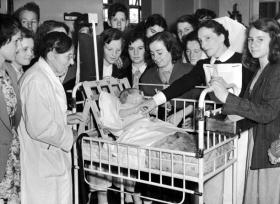
Kathleen Lynn in St Ultan’s, 1953. (Irish Press)
At St Ultan’s the staff gradually expanded, with Miss Jones employed as a pathologist. She visited Berlin to carry out research. In 1926 Dr Margaret Enright was appointed bacteriologist. She had been an assistant bacteriologist at UCC, and conducted research on the microbes found on babies’ comforters. This research was important, since the biggest killer of infants in St Ultan’s was gastro-enteritis, an infectious disease. In 1926, 21 of the 48 deaths in the hospital were due to this disease. Furthermore, the emphasis on Continental research at the hospital was to influence Dr Dorothy Stopford-Price.
St Ultan’s most important legacy was its pioneering research, particularly in relation to the prevention of tuberculosis. This was particularly associated with Dr Dorothy Stopford-Price, who was the first person to introduce the BCG vaccination to Ireland (it arrived from Sweden to St Ultan’s in January 1937). Dr Stopford-Price began working in St Ultan’s in 1923, when she accepted the position of assistant physician. She was influenced by Dr Katherine Maguire, who had encouraged Alexandra College to establish the Guild Tenement Company because of the dreadful conditions in the Dublin tenements. Dr Maguire wrote an article entitled ‘The social conditions of the Dublin poor’ in the Alexandra College Magazine. Both Maguire and Stopford-Price wanted to eliminate the causes of ill health, particularly among children. Dr Stopford-Price was nominated for the World Health Organisation Leon Bernard prize for her contribution to social medicine.
By the late 1920s St Ultan’s had 35 cots, a matron, a sister, five staff nurses and six probationers. Patients came from all over the country. In keeping with the social outlook of the hospital, annual reports contain detailed records of the background of the patients, including the proportion whose father was unemployed. In 1924 this was 44 per cent, and the report also noted that fifteen per cent of the patients were ‘illegitimate’. St Ultan’s also sought to support families, and in the 1930s the St Ultan’s Hospital Utility Society was to establish model tenement homes, as the Alexandra Guild had done, in order to break the cycle of poverty and ill health.
Conclusion
What was the role of St Ultan’s? It was yet another example of female doctors creating their own niche, in this case paediatrics. Its staff list reads like a who’s who of prominent female paediatricians, with Drs Maguire, Lynn and Price gaining valuable experience there. The hospital provided these professionals with the freedom to run an institution as they saw fit. Doctors who subsequently made their name abroad benefited from the St Ultan’s experience. Apart from improving the health of countless children, perhaps St Ultan’s legacy for professional women was the confidence it inspired. The hospital helped female doctors to make their mark in the medical world. Furthermore, the hospital was a physical manifestation of the personal medical philosophy of Dr Kathleen Lynn. However, in the 1930s a hospital that was managed by multi-denominational, independent—and, in the case of Lynn, idiosyncratic—women was not trusted with the care of older children. Ultimately, the large children’s hospital in Crumlin was built with the blessing, literally, of Dr John Charles McQuaid in the 1950s.
St Ultan’s was never more than a small, if dynamic, infants’ hospital. However, in this micro-picture of a specific institution one can see national developments taking place. The concern with national regeneration, whether through cultural, educational or medical organisations, was evident in the formative years of the state in the 1920s. Perhaps by examining the minutiae of Irish life we may emerge with a clearer picture of the past, particularly the socio-economic trends that are so vital in the ‘unregarded lives’ that tend to be absent from the larger political picture.
Margaret Ó hÓgartaigh is a Fellow of the Royal Academy of Medicine in Ireland.
Further reading:
I. Finn, ‘Women in the medical profession in Ireland, 1876–1919’, in B. Whelan (ed.), Women and paid work in Ireland, 1500–1930 (Dublin, 2000).
G. Jones, ‘Captain of all these men of death’. The history of tuberculosis in nineteenth- and twentieth-century Ireland (Amsterdam and New York, 2001).
M. Ó hÓgartaigh, ‘Dr Dorothy Stopford-Price and the elimination of childhood tuberculosis’, in J. Augusteijn (ed.), Ireland in the 1930s. New perspectives (Dublin, 1999).
M. Ó hÓgartaigh, Kathleen Lynn, patriot doctor (Dublin, 2005).
















